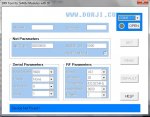Do you have the setup tool from Dorji, if so then setup should be very simple.
As for the first byte needing to be $0 that is not needed, it should except any data sent, so it may be a fault in the setup.
The setup tool looks like this.

The serial parameters need to be set to the baud of the picaxe on both wireless modules, then the RF parameters need to be set to a faster baud then the serial baud, this is because the RF needs to transmit the data faster then the serial data is received to the module, or the FIFO buffer will be filled and missed data will occur.
Example .. serial 4800 baud and RF 9600 baud.
The "Net ID" and the "Node ID" need to match in both wireless modules or they will not talk to each other.
Also the "Channel" needs to match in both modules.
All very simple to setup using the setup tool.
To put the modules into setup you do require the Dorji USB adaptor and place a jumper across the 2 header pins marked "set"
Also with the L1 module you can connect it direct to the picaxe programming port (serial out) (with additional 5V) and simply use Sertxd to send data as you would if sending data out to the computer screen, this is how I use these modules.

